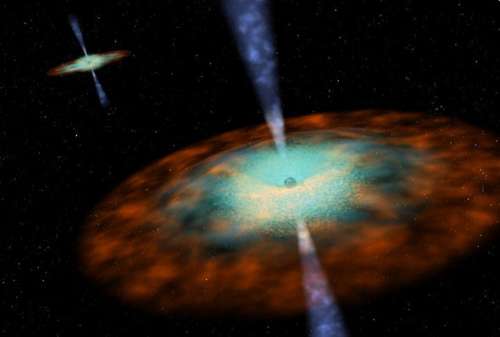
Astronomers have obtained the most compelling evidence yet that massive objects dramatically warp space–time, as predicted by Einstein’s general theory of relativity. Although the geometric nature of gravity was first demonstrated in 1919, when Arthur Eddington famously detected the subtle warping effect of the Sun on the light from distant stars, the new results provide the first test of Einstein’s theory in much stronger gravitational fields.
In fact, team leader Mauri Valtonen of Tuorla Observatory in Finland claims the work provides the first hard evidence for black holes, which are so massive that space–time is predicted to completely curve in on itself: “People refer to the concept of black holes all the time, but strictly speaking one first has to prove that general relativity holds in strong gravitational fields before we can be sure that black holes exist,” he told physicsworld.com.
Binary system
The new test of general relativity concerns a distant galactic core or quasar called OJ287, which is known to emit a pair of bright optical bursts every 12 years or so. In 1988, Valtonen and others suggested that this emission is powered by a primary black hole 18 billion times more massive than the Sun, around which orbits a second black hole some 200 times lighter. In such a binary system, the lighter object passes through matter in the accretion disk of the primary black hole twice per orbit, releasing a burst of energy each time it does so.
By modelling such a system, researchers could then put general relativity to the test by predicting when the next burst should occur. At the time, the next major bursts (which were due in the mid 1990s) could only be predicted with an accuracy of a few weeks, which was too vague to test general relativistic effects. But early last year, based on refined models and years spent monitoring OJ287, Valtonen and others were able to predict the date on which the next bright pulse should appear: 13 September 2007, give or take a day or two.
To have any hope of detecting the pulse, more than 25 astronomers from 10 countries had to work together. This is because in September OJ287 rises in the east just before sunrise, and is therefore only visible at any one location on Earth for about 30 minutes before the sky becomes too bright. By starting observations in Japan, followed by China, Europe and ending in the Canary Islands, observers were able to follow the sunrise westward around the globe and maximise observing time. In total, about 100 measurements were made between 4 September and 20 October, some of which by amateur astronomers.
Successful campaign
The quasar pulse occurred right on schedule, strongly suggesting that OJ287 is a binary black hole system (Nature 452 851). In addition to verifying the enormous mass of the primary black hole, the result shows that the orbit of the secondary black hole precesses at a rate of 39 degrees per period. For comparison, the distorting effect of the Sun on the local space–time causes Mercury’s orbit to precess by little more than 0.1 degrees per century.
Furthermore, the work suggests that the binary system is losing energy by emitting gravitational waves — a key prediction of Einstein’s theory that is yet to be verified directly. When this emission is not included in the model, the quasar outburst is predicted to occur 20 days later, providing indirect support for gravitational waves. Indeed, according to Valtonen, the rate of emission observed in OJ287 make it the brightest known source of gravitational waves in the universe, and therefore a good target for the Laser Interformeter Space Antenna (LISA) — especially in the period 2016–2019 when the next big outbursts are due.



